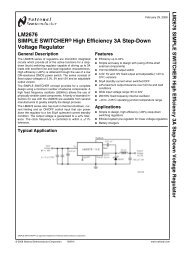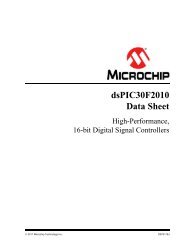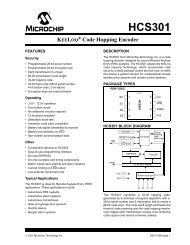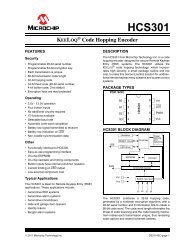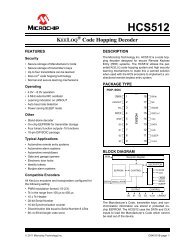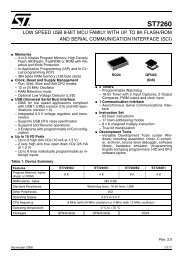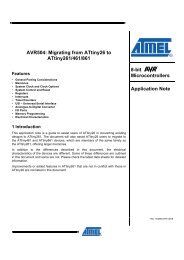You also want an ePaper? Increase the reach of your titles
YUMPU automatically turns print PDFs into web optimized ePapers that Google loves.
<strong>STM32W108C8</strong><br />
Description<br />
1.2 Overview<br />
1.2.1 Functional description<br />
The <strong>STM32W108C8</strong> radio receiver is a low-IF, super-heterodyne receiver. The architecture<br />
has been chosen to optimize co-existence with other devices in the 2.4 GHz band (namely,<br />
WIFI and Bluetooth), and to minimize power consumption. The receiver uses differential<br />
signal paths to reduce sensitivity to noise interference. Following RF amplification, the signal<br />
is downconverted by an image-rejecting mixer, filtered, and then digitized by an ADC.<br />
The radio transmitter uses an efficient architecture in which the data stream directly<br />
modulates the VCO frequency. An integrated power amplifier (PA) provides the output<br />
power. Digital logic controls Tx path and output power calibration. If the <strong>STM32W108C8</strong> is to<br />
be used with an external PA, use the TX_ACTIVE or nTX_ACTIVE signal to control the<br />
timing of the external switching logic.<br />
The integrated 4.8 GHz VCO and loop filter minimize off-chip circuitry. Only a 24 MHz<br />
crystal with its loading capacitors is required to establish the PLL local oscillator signal.<br />
The MAC interfaces the on-chip RAM to the Rx and Tx baseband modules. The MAC<br />
provides hardware-based IEEE 802.15.4 packet-level filtering. It supplies an accurate<br />
symbol time base that minimizes the synchronization effort of the software stack and meets<br />
the protocol timing requirements. In addition, it provides timer and synchronization<br />
assistance for the IEEE 802.15.4 CSMA-CA algorithm.<br />
The <strong>STM32W108C8</strong> integrates an ARM® Cortex-M3 microprocessor, revision r1p1. This<br />
industry-leading core provides 32 bit performance and is very power efficient. It has<br />
excellent code density using the ARM® Thumb 2 instruction set. The processor can be<br />
operated at 12 MHz or 24 MHz when using the crystal oscillator, or at 6 MHz or 12 MHz<br />
when using the integrated high frequency RC oscillator.<br />
The <strong>STM32W108C8</strong> has 64 Kbytes of Flash memory, 8 Kbytes of SRAM on-chip, and the<br />
ARM configurable memory protection unit (MPU).<br />
The <strong>STM32W108C8</strong> contains 24 GPIO pins shared with other peripheral or alternate<br />
functions. Because of flexible routing within the <strong>STM32W108C8</strong>, external devices can use<br />
the alternate functions on a variety of different GPIOs. The integrated Serial Controller SC1<br />
can be configured for SPI (master or slave), I 2 C (master-only), or UART operation, and the<br />
Serial Controller SC2 can be configured for SPI (master or slave) or I 2 C (master-only)<br />
operation.<br />
The <strong>STM32W108C8</strong> has a general purpose ADC which can sample analog signals from six<br />
GPIO pins in single-ended or differential modes. It can also sample the regulated supply<br />
VDD_PADSA, the voltage reference VREF, and GND. The ADC has two selectable voltage<br />
ranges: 0 V to 1.2 V (normal) and 0.1 V to 0.1 V below the high voltage supply (high). The<br />
ADC has a DMA mode to capture samples and automatically transfer them into RAM. The<br />
integrated voltage reference for the ADC, VREF, can be made available to external circuitry.<br />
An external voltage reference can also be driven into the ADC.<br />
The <strong>STM32W108C8</strong> contains four oscillators: a high frequency 24 MHz external crystal<br />
oscillator, a high frequency 12 MHz internal RC oscillator, an optional low frequency 32.768<br />
kHz external crystal oscillator, and a 10 kHz internal RC oscillator.<br />
The <strong>STM32W108C8</strong> has an ultra low power, deep sleep state with a choice of clocking<br />
modes. The sleep timer can be clocked with either the external 32.768 kHz crystal oscillator<br />
or with a 1 kHz clock derived from the internal 10 kHz RC oscillator. Alternatively, all clocks<br />
Doc ID 018587 Rev 2 12/215





